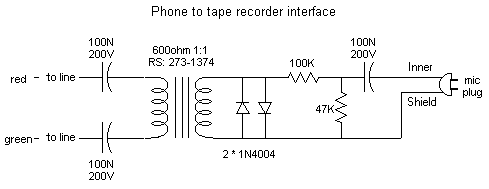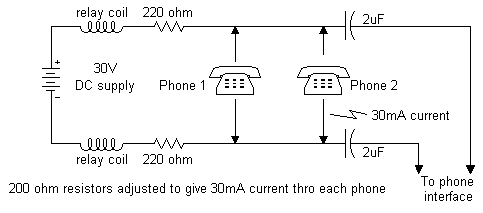Also see: Recording EVP Using a Telephone and EVP Using VoIP and Telephones
 The above device permits the connection of a household phone (and phone line) to a tape recorder or computer soundcard for EVP voice recording purposes.
The above device permits the connection of a household phone (and phone line) to a tape recorder or computer soundcard for EVP voice recording purposes.
The device input taps directly onto the (undisturbed) phone connection wiring, with the output having a microphone (or sound card) audio plug via shielded cable.
When used in this way, the telephones are used as a modified form of tape recorder microphone for receiving EVP voices as per the standard microphone method. The procedure that has been mentioned previously in the AA-EVP newsletter may be useful – that is, letting the phone go “dead” after picking up the handset – then recording. A faint background sound source may be useful with this microphone method – perhaps a local radio tuned to static / low level voice babble.
If there are two phones on the same line, both may be used simultaneously (see later comments).
When used, the phone network supplies power to energize the telephones when the handset is lifted, and the device then channels the audio to the recorder or sound card.
Older models of telephone may work better with this method, one reason being due to them having the older carbon microphone, rather than the more modern electric version.
Circuit Details
The two 100N caps connected to the line are to isolate the phone line DC from the transformer, preventing any call set-up requests to the phone exchange when the device is connected (phone exchange will not sense this device). Device connects to red and green wires (in USA) of phone termination. Do not remove any existing wires at termination.
The transformer provides balanced input to unbalanced output, so the microphone plug can be grounded via the recorder without upsetting phone line balance.
The 100K / 4K7 resistors drop the line audio level so to be compatible with normal microphone input sensitivities.
The two cross connected diodes ensure that any ringing voltages do not damage the tape recorder (if the phone rings while this device is connected the tape recorder will not be damaged).
Construction
A metal enclosure would be preferable to avoid hum pick-up.
Shielded cable should be used between microphone plug and the box and its components. The metal case (if used) should be connected to the cable shield ground.
Simulated Local Telephone Network
(not connected to phone company)
 A couple of stand-alone telephones can be energized locally to form a simulated network (see above diagram) for experimentation. The output shown, connects to the phone interface.
A couple of stand-alone telephones can be energized locally to form a simulated network (see above diagram) for experimentation. The output shown, connects to the phone interface.
A 30V (approximately) supply is used to energize the phone, and this voltage is fed to the phone via two sets of relay coils and resistors. The coils ensure that derived audio is not attenuated by the power supply, and the resistors set the standing current flowing through the phones. This current should be set to 30mA per phone. If preferable, the power supply voltage can be altered instead, to achieve the 30mA.
The use of two telephones may provide advantage over a single unit for the purposes of EVP reception, as there is a circulating interaction of simultaneous audio currents between the two units, which may aid reception.
The two 2uF capacitors may not be needed if the above device only connects to the interface unit – as the interface already has DC input blocking.
![]()
